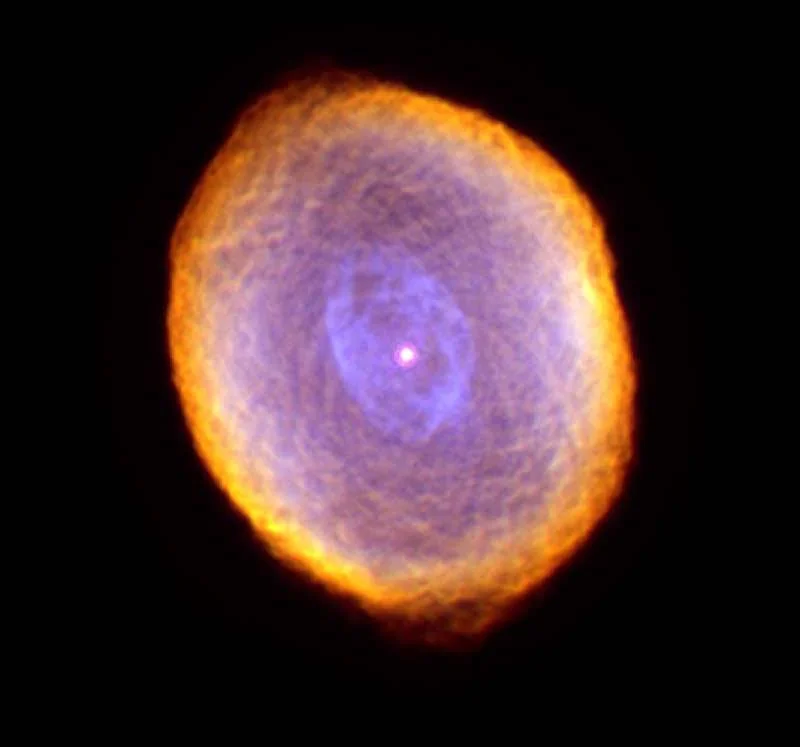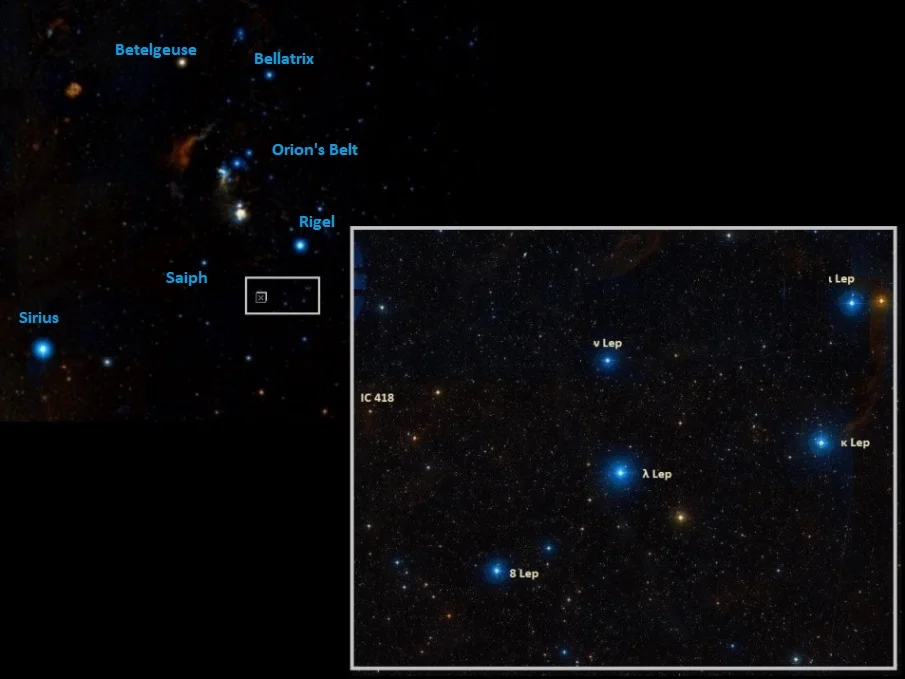Planetary Nebula at Orion's Feet – Constellation Guide (original) (raw)
The Spirograph Nebula (IC 418) is a planetary nebula located approximately 3,600 light years away in the constellation Lepus. It lies near the ears of the celestial Hare, just under Orion‘s feet. Named for its elaborate pattern, the nebula is notable for its system of filaments and multiple shells that surround the bright central nebulosity.
IC 418 was named after the spirograph, a geometric drawing device that produces roulette curves known as hypotrochoids and epitrochoids. With an apparent magnitude of 9.6, it was a familiar night sky object to observers even before it was captured by the Hubble Space Telescope, but the detailed view of its intricate structure provided by the Hubble Wide Field Planetary Camera 2 (WFPC2) in 1999 gave the nebula its name.
The Spirograph Nebula stretches 0.3 light years across. It was formed a few thousand years ago when the central star, a red giant at the time, reached the end of its life and expelled its outer layers into space. The ejected material formed the expanding nebula. The clouds of material are illuminated by the radiation of the stellar core. As the stellar remnant continues to cool and fade away, the nebula will slowly disperse into the surrounding space over the next few thousand years. The central star will continue to fade away as a white dwarf for billions of years.

The Spirograph Nebula (IC 418), photographed by the Hubble Space Telescope’s Wide Field Planetary Camera 2. Image: NASA and The Hubble Heritage Team (STScI/AURA)
A study published in 2009 found an angular expansion rate of the nebula’s ionization front of 5.8 ± 1.5 mas/yr. A 2012 study reported the discovery of multiple shells and low surface brightness structures around the central nebula. The structures include radial filaments that emanate from the nebula’s bright shell, three concentric rings around the inner shell, and two detached haloes with apparent sizes of about 150 arcseconds and 220 by 250 arcseconds.
The inner shell occupies an area of 3.5 by 5.5 arcseconds and the outer one, 11 by 14 arcseconds. The same study used modelling to derive an expansion rate of the nebula of 15.7 km/s at the poles and 12.6 km/s at the equator. The model yielded a kinematical age of 2,600 ± 800 years for the inner shell, about 47,000 years for the inner halo, and 69,000 years for the outer halo. This indicates three major episodes of mass loss separated by tens of thousands of years. The final one resulted in the formation of the central nebula about 3,000 years ago.
The central star, catalogued as HD 35914, has an apparent magnitude of 10.1. A study published in 1997 reported detecting brightness variations on two different time scales, one on the order of days and the other with a period of 6.5 hours. The long-term variations in the star’s brightness were reported to be accompanied by colour variations. The star appeared redder when it brightened. The star’s variability can be explained by either pulsations or variations in mass loss. Subsequent studies found that more than 30% of central stars in planetary nebulae with effective temperatures between 25,000 K and 50,000 K showed similar variations in luminosity.
Location
The Spirograph Nebula is easy to find but requires larger instruments to be seen. It lies in the constellation Lepus, just south of the hourglass figure of Orion. The nebula forms a triangle with Saiph and Rigel, the bright stars that mark Orion’s feet, and can be found just east of a parallelogram of stars similar to that formed by the brightest stars of Lyra. The parallelogram pattern lies just south of Rigel and marks the ears of the celestial Hare. It is formed by Nu (mag. 5.29), Iota (mag. 4.45), Kappa (mag. 4.43), and Lambda Leporis (mag. 4.286).

Spirograph Nebula location, image: Wikisky
IC 418 is quite small and best seen at high magnification. The best time of year to observe the stars and deep sky objects in Lepus is during the winter months.
Spirograph Nebula – IC 418
| Constellation | Lepus |
|---|---|
| Right ascension | 05h 27m 28.2060343141s |
| Declination | −12° 41′ 50.282659007″ |
| Apparent size | 3.5″x5.5″ |
| 11″x14″ | |
| 150″ | |
| 220″x250″ | |
| Apparent magnitude | 9.6 |
| Distance | 3,600 ± 1,000 light years (1,100 ± parsecs) |
| Radius | 0.15 light years |
| Names and designations | Spirograph Nebula, IC 418, HD 35914, Gaia DR2 2985789113026163584, PK 215-24 1, PN G215.2-24.2, IRAS 05251-1244, BD-12 1172, ARO 3, VV 22, VV’ 32 |